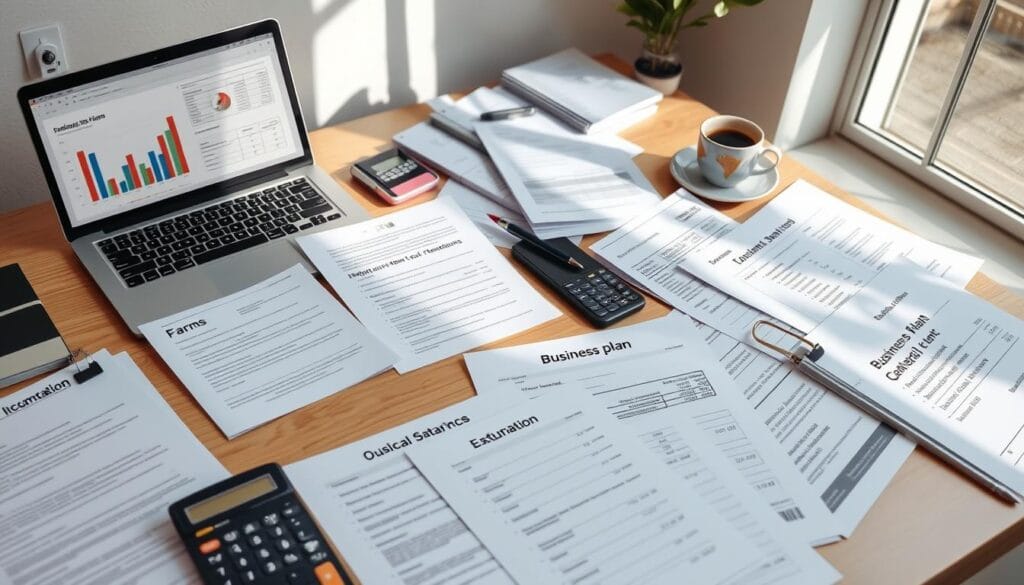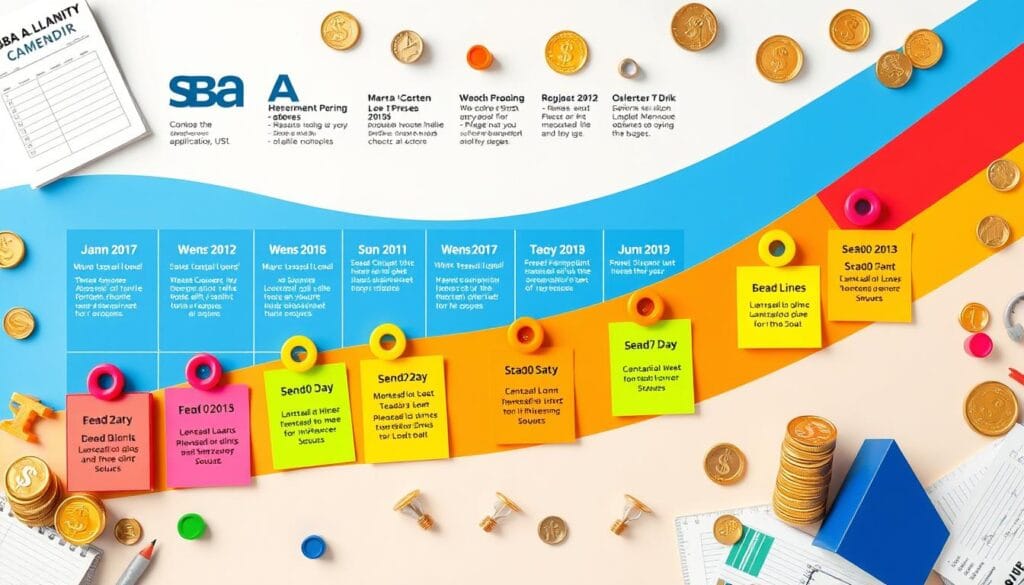How to Apply for SBA Loans: A Step-by-Step Guide

As a small business owner, getting the right financing is crucial. The U.S. Small Business Administration (SBA) offers affordable and accessible loan programs. These have helped many businesses grow. In this guide, we’ll show you how to apply for an SBA loan. This will help you get the capital you need to reach your goals.
SBA loans have lower interest rates and more flexible terms. They also offer higher loan amounts than traditional financing. Whether you’re starting or expanding, the SBA has loan programs for you. These loans cover startup costs, working capital, and more, helping your business grow.
Next, you’ll learn about the key requirements and the application process. With the right preparation and guidance, you can get the financial help your business needs. Let’s explore how SBA financing can help you achieve your business dreams.
Table of Contents
Understanding SBA Loans and Their Benefits
Small businesses in the United States have access to a valuable financing option in the form of SBA loans. These government-backed loans, offered through the Small Business Administration (SBA), provide competitive interest rates, flexible repayment terms, and attractive features. They make them an appealing choice for entrepreneurs and small business owners.
What Makes SBA Loans Attractive to Small Businesses
SBA loans offer several key advantages that make them a desirable financing solution for small businesses. These include:
- Competitive Interest Rates: SBA loans typically come with fixed-rate options. This provides predictable monthly payments without unexpected increases or balloon payments.
- Longer Repayment Terms: The SBA guarantee allows lenders to offer longer repayment terms. Often up to 10 years for working capital or inventory loans, 10 years for equipment, and 25 years for real estate.
- Lower Down Payments: SBA 504 loans require a down payment of 10% or more. This is generally lower than the 20-30% down payment often required for conventional commercial loans.
Key Advantages of SBA-Backed Financing
In addition to the favorable interest rates and repayment terms, SBA loans offer several other key advantages. These make them an attractive financing option for small businesses:
- Larger Loan Maximums: SBA 7(a) loans can provide up to $5 million in funding. SBA 504 loans can offer up to $5 million, or potentially $5.5 million for specific projects.
- Flexible Loan Purposes: SBA loans can be used for a wide range of business needs. This includes working capital, equipment purchases, real estate acquisition, and more.
- Reduced Collateral Requirements: SBA loans often have more lenient collateral requirements. This makes them accessible to a broader range of small businesses.
Common Types of SBA Loan Programs
The SBA offers several loan programs to meet the diverse financing needs of small businesses. Some of the most common SBA loan programs include:
- SBA 7(a) Loan Program: The 7(a) loan is the SBA’s primary and most versatile loan program. It offers financing up to $5 million with terms up to 25 years for real estate.
- SBA 504 Loan Program: The CDC/504 loan program is designed to finance major fixed assets. This includes commercial real estate or heavy equipment, with loan amounts up to $5 million.
- SBA Microloan Program: The Microloan program provides small loans up to $50,000. It helps startups and small businesses access working capital or purchase small equipment.
Regardless of the specific SBA loan program, these government-backed financing options offer small businesses in the United States a valuable resource. They fuel their growth and success.
Basic Eligibility Requirements for SBA Loans
To get an SBA loan, your business must meet certain criteria. It should be a for-profit business operating in the U.S. Your business should have fewer than 500 employees and make less than $7.5 million a year. The SBA looks at your business size based on employees and revenue, usually between 50 to 1,500 employees and $1 million to $41.5 million in revenue.
Your business must have tried other funding options first. Some businesses, like those in illegal activities or loan packaging, are not eligible. This includes gambling, investment, or lending.
- The SBA requires that anyone with 20% or more ownership in the business provide an unlimited personal guarantee.
- For 7(a) small loans, applicants need a FICO Small Business Scoring Service (SBSS) score of 155 or higher.
- Newer businesses may struggle to qualify for an SBA loan due to the requirement of having two or more years of business operation.
- SBA 504/CDC loans require a business to have an average net income of less than $5 million for the past two years and a tangible net worth of less than $15 million.
- SBA microloans entail collateral and personal guarantees but may have more flexible eligibility criteria compared to traditional SBA loans.
Knowing these basic requirements helps prepare your business for an SBA loan. This increases your chances of getting the funding you need to grow and succeed.
| SBA Loan Type | Eligibility Criteria |
|---|---|
| 7(a) Loan | FICO SBSS score of 155 or higher |
| 504/CDC Loan | Average net income less than $5 million, tangible net worth less than $15 million |
| SBA Microloan | More flexible eligibility criteria, collateral and personal guarantees required |
How to Apply for SBA Loans
Applying for an SBA loan might seem hard, but it’s doable with the right help. You can get an SBA-backed loan to grow your business. First, learn about SBA loan programs, find good SBA lenders, and know how to apply.
Choosing the Right SBA Loan Program
The SBA has many loan programs for different business needs. The 7(a) Loan Program, CDC/504 Loan Program, and SBA Microloan Program are popular. Pick the one that fits your business goals and needs.
Finding an SBA-Approved Lender
After picking a loan program, find an SBA-approved lender. Use the SBA’s Lender Match tool or contact local banks and credit unions. These SBA lending partners know the small business loan application process well and can help with paperwork.
Initial Application Steps
To start, collect needed documents like financial statements and business plans. The SBA and your lender will check your credit. Have all your info ready to make the small business loan application process smoother and boost your chances of getting the loan.
Essential Documentation Required for Your Application
Getting an SBA loan means you need to show your business is financially sound. The SBA loan application process asks for a lot of documents. Knowing what you need can make things easier.
Here are some key documents you’ll have to provide:
- Six months of business bank statements
- A valid driver’s license or state ID
- A voided business account check
- Month-to-date transactions
- Two years of business and personal tax returns
- A debt schedule
- Year-to-date profit and loss statement
- Balance sheet
- Cash flow projections
- A collateral list
- Business certificates or licenses
- Loan application history
- Business owner resume(s)
- Business plan
- Business lease (if applicable)
The SBA also needs specific forms. These include Form 1919, Form 912, Form 413, and Form 148.
Getting all the required documentation for SBA loans takes time. But it’s key to a successful application. Having everything ready will help you get the funding your business needs.

The SBA loan application process checks if your business can handle the loan. So, it’s important to be ready with all the documents. Organize everything well, and you’ll be closer to getting the SBA financing your business needs.
Financial Requirements and Credit Criteria
When you apply for an SBA loan, you need to meet certain financial and credit standards. These rules help lenders know if you can pay back the loan. They check if you have good credit and enough money to repay the loan.
Minimum Credit Score Requirements
SBA loans don’t have a single minimum credit score. But, most lenders want a score of 680 to 700 or more. For SBA Small Loans, a FICO SBSS score of at least 155 is needed, ranging from 0 to 300.
Business Revenue and Time in Business
You also need to show your business has made money and has been around for a while. The time needed can be as short as 6 months or as long as 2 years or more. Lenders look at your financial statements to see if you can handle the SBA loan interest rates.
Collateral and Down Payment Requirements
SBA loans often ask for collateral, like real estate or equipment, worth the loan amount. You might also need to put down 10-30% of the loan. Lenders also check your debt-to-income ratio and debt service coverage ratio.
It’s important to meet these SBA loan eligibility requirements to get an SBA-backed loan. You’ll need to share detailed financial info and show you can repay the loan.
The SBA Loan Application Process Timeline
Getting an SBA loan is key for small businesses looking for funding. But, the application process can seem overwhelming. The time it takes to get an SBA loan varies a lot. It depends on the loan type and the lender you pick.
The SBA 7(a) loan process usually takes 60 to 90 days. SBA Microloans are faster, taking 30 to 90 days. The SBA 504/CDC loan can take up to 6 months. For those in a hurry, SBA Express loans are the quickest, with approval in 5 to 30 days.
Several things can affect how long it takes to get a loan. These include how complete your application is, your credit score, and the lender’s review time. After you apply, the lender might ask for more info or documents. Once approved, you’ll get a loan proposal with the terms and fees. Then, the lender and SBA will review it together.
| Loan Program | Typical Approval and Funding Timeline |
|---|---|
| SBA 7(a) Loan | 60 to 90 days |
| SBA Microloan | 30 to 90 days |
| SBA 504/CDC Loan | Up to 6 months |
| SBA Express Loan | 5 to 30 days |
Knowing the typical timeline for SBA loans helps small business owners plan better. Being organized and quick to respond can speed up the process. This increases your chances of getting the SBA loan your business needs.

Common Reasons for SBA Loan Denials
Getting an SBA loan is tough, with only about one-third of applicants getting full approval in 2023. Knowing why SBA loans get denied is key for small business owners. Let’s look at the main reasons why an SBA loan application might be turned down.
Poor credit scores are a big reason for SBA loan denials. The SBA looks for a minimum credit score of 680 or higher. If a business doesn’t meet this, it might face challenges. Other reasons include not enough business revenue, being new, or lacking the right collateral or down payment.
Businesses also need to show they can pay back the loan. If they can’t, the loan might be denied. Other reasons include past bankruptcies, negative taxable income, or being in ineligible business types like gambling or adult entertainment.
Even small issues like past violent or financial crimes can stop an SBA loan. The SBA has strict rules, and any rule-breaking can hurt your application.
The SBA loan process is very competitive. Even if a business meets the basic requirements, it might still face hurdles. Knowing why loans get denied can help small business owners prepare better. This way, they can increase their chances of getting SBA-backed financing.
| Reason for SBA Loan Denial | Description |
|---|---|
| Poor Credit Score | The SBA sets minimum credit score requirements, typically around 680 or higher. |
| Insufficient Business Revenue | Businesses must demonstrate sufficient revenue to service the loan. |
| Lack of Collateral or Down Payment | The SBA requires adequate collateral and a down payment to secure the loan. |
| Inability to Demonstrate Repayment Capacity | Businesses must prove they have the financial means to repay the loan. |
| Prior Bankruptcies or Negative Taxable Income | The SBA may deny applications with a history of financial difficulties. |
| Involvement in Ineligible Business Types | The SBA does not provide financing for certain industries, such as gambling or adult businesses. |
By understanding these common reasons for SBA loan denials, small business owners can better prepare their applications. This increases their chances of getting this valuable financing.
Alternative Financing Options if Your SBA Loan is Denied
If your small business loan application for an SBA loan program is denied, don’t lose hope. There are many other financing options you can look into. These can help you get the funding your business needs.
Equipment Financing Options
Equipment financing is a good choice if you need to buy or upgrade equipment. These loans or leases are made to help you get the equipment you need to grow your business.
Traditional Business Loans
Traditional term business loans from banks or online lenders are another option. These loans might have different rules and terms than SBA loans. But, they could be a good choice if your business has a strong credit score and financial history.
Business Lines of Credit
A business line of credit gives you flexible access to funds up to a set limit. It’s great for managing cash flow and covering short-term expenses. It could be a good alternative if your SBA loan application was denied.
Keep in mind, these options might have different rules and terms than SBA loans. But, they can still be great for businesses that don’t qualify for SBA financing. Make sure to research and compare your options to find the best fit for your small business loan application process.
Conclusion
SBA loans are great for small businesses, offering good rates and terms. Knowing how to apply and what you need is key. This can help you get approved.
The process might seem hard and slow. But, if you prepare well and meet the financial needs, you might get a loan.
If you’re turned down for an SBA loan, don’t worry. There are other ways to get money, like equipment loans or business lines of credit. These can help you reach your business goals.
Remember, SBA loans are just one option for small business owners in the U.S. There are many other funding sources out there.
By following the steps to apply for SBA loans, you can get the financing you need. This can help your business grow. Stay focused, patient, and quick to respond during the application process. This will help you succeed.






One Comment
Comments are closed.